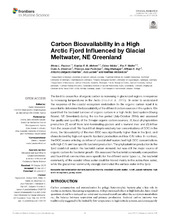| dc.contributor.author | Paulsen, Maria Lund | |
| dc.contributor.author | Nielsen, Sophia Elisabeth Bardram | |
| dc.contributor.author | Müller, Oliver | |
| dc.contributor.author | Møller, Eva Friis | |
| dc.contributor.author | Stedmon, Colin A. | |
| dc.contributor.author | Juul-Pedersen, Thomas | |
| dc.contributor.author | Markager, Stiig | |
| dc.contributor.author | Sejr, Mikael Kristian | |
| dc.contributor.author | Delgado Huertas, Antonio | |
| dc.contributor.author | Larsen, Aud | |
| dc.contributor.author | Middelboe, Mathias | |
| dc.date.accessioned | 2018-02-09T08:51:44Z | |
| dc.date.available | 2018-02-09T08:51:44Z | |
| dc.date.issued | 2017-06-08 | |
| dc.identifier.issn | 2296-7745 | en_US |
| dc.identifier.uri | https://hdl.handle.net/1956/17359 | |
| dc.description.abstract | The land-to-ocean flux of organic carbon is increasing in glacierized regions in response to increasing temperatures in the Arctic (Hood et al., 2015). In order to understand the response of the coastal ecosystem metabolism to the organic carbon input it is essential to determine the bioavailability of the different carbon sources in the system.We quantified the bacterial turnover of organic carbon in a high Arctic fjord system (Young Sound, NE Greenland) during the ice-free period (July-October 2014) and assessed the quality and quantity of the 3 major organic carbon sources; (1) local phytoplankton production (2) runoff from land-terminating glaciers and a lowland river and (3) inflow from the ocean shelf. We found that despite relatively low concentrations of DOC in the rivers, the bioavailability of the river–DOC was significantly higher than in the fjord, and characterized by high cell-specific bacterial production and low C:N ratios. In contrast, the DOC source entering via inflow of coastal shelf waters had high DOC concentrations with high C:N and low specific bacterial production. The phytoplankton production in the fjord could not sustain the bacterial carbon demand, but was still the major source of organic carbon for bacterial growth. We assessed the bacterial community composition and found that communities were specific for the different water types i.e., the bacterial community of the coastal inflow water could be traced mainly in the subsurface water, while the glacial river community strongly dominated the surface water in the fjord. | en_US |
| dc.language.iso | eng | eng |
| dc.publisher | Frontiers | en_US |
| dc.relation.ispartof | <a href="http://hdl.handle.net/1956/17362" target="blank">Microbial dynamics in high latitude ecosystems. Responses to mixing, runoff and seasonal variation a rapidly changing environment</a> | en_US |
| dc.rights | Attribution CC BY | eng |
| dc.rights.uri | http://creativecommons.org/licenses/by/4.0/ | eng |
| dc.subject | bacterial carbon demand | eng |
| dc.subject | bacterial diversity | eng |
| dc.subject | dissolved organic matter | eng |
| dc.subject | runoff | eng |
| dc.subject | glacial meltwater | eng |
| dc.subject | high arctic ecosystems | eng |
| dc.subject | young sound | eng |
| dc.title | Carbon Bioavailability in a High Arctic Fjord Influenced by Glacial Meltwater, NE Greenland | en_US |
| dc.type | Peer reviewed | |
| dc.type | Journal article | |
| dc.description.version | publishedVersion | en_US |
| dc.rights.holder | Copyright 2017 Paulsen, Nielsen, Müller, Møller, Stedmon, Juul-Pedersen, Markager, Sejr, Delgado Huertas, Larsen and Middelboe. | en_US |
| dc.source.articlenumber | 176 | |
| dc.identifier.doi | https://doi.org/10.3389/fmars.2017.00176 | |
| dc.identifier.cristin | 1519644 | |
| dc.source.journal | Frontiers in Marine Science | |
| dc.source.40 | 4 | |

